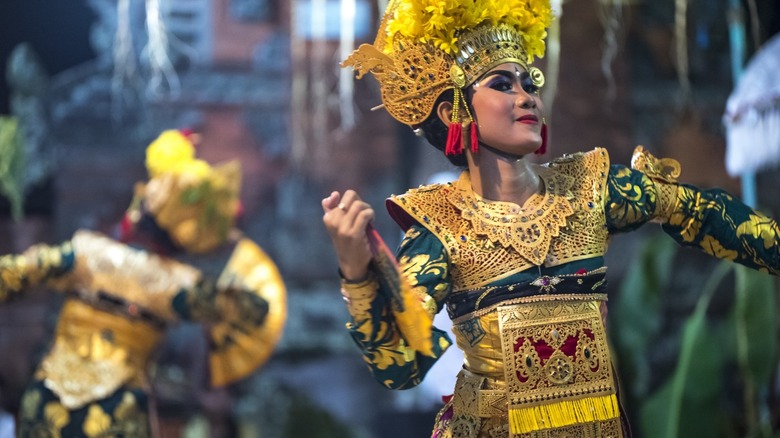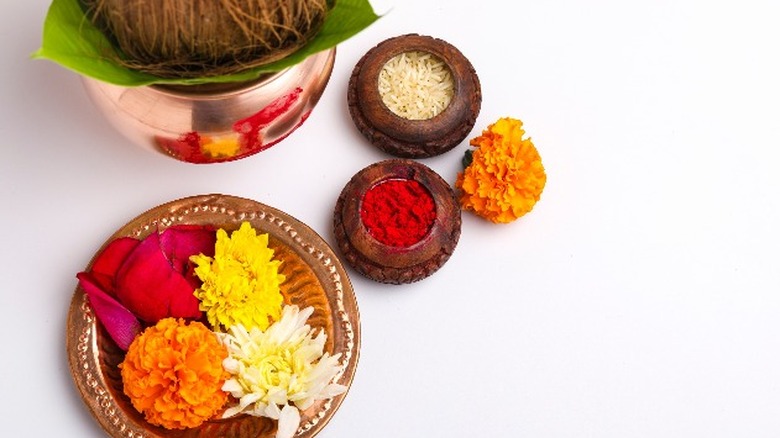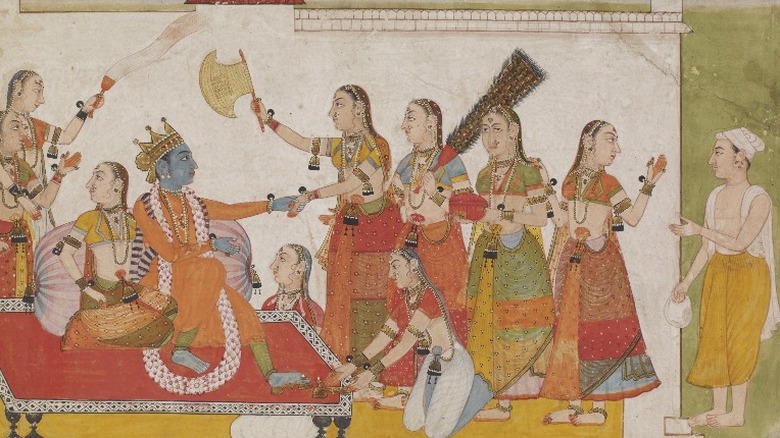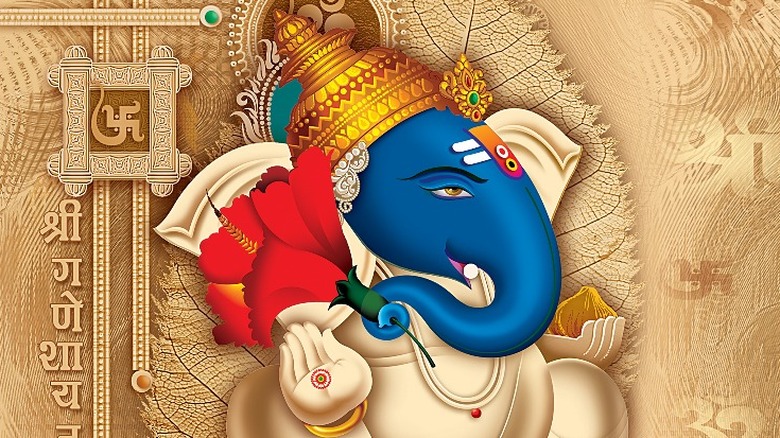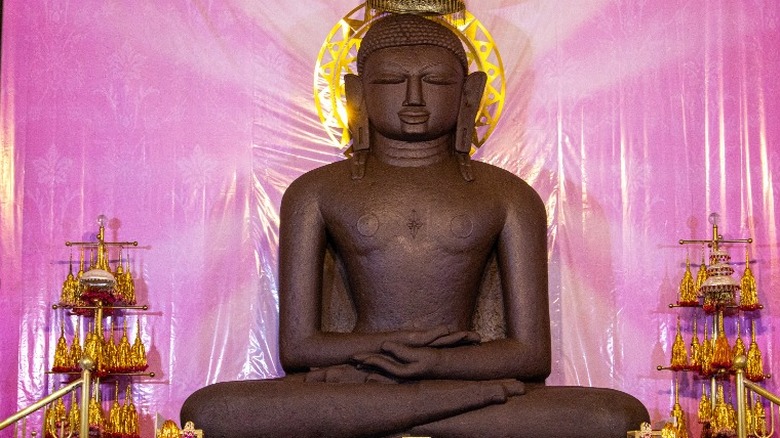The Annual Hindu And Jain Festival Akshaya Tritiya Explained
Falling on May 3 this year, the festival of Akshaya Tritiya has many different associations for the Hindus and Jains who celebrate it all over the world. The two religions are separate but share many of the same tenets and some of the same holidays. Jainism is one of the oldest religions in India, with its origins probably in the first century B.C. It's based around the values of nonviolence and respect for all living things (via National Geographic). It's similar to Hinduism, though Hinduism is even older (via History).
The name of the holiday, Akshaya Tritiya, comes from Sanskrit. According to NDTV, Akshaya means "never diminishing," and Tritiya means "third day." That's a reference to when the holiday is celebrated: on the third day of the bright half of Vaishakh month of the Hindu calendar (via Learn Religions). This corresponds to April or May on the Gregorian calendar. The festival is also sometimes called Akha Teej. The day is considered one of the most auspicious of the year, associated with good luck, good deeds, and undertaking new activities (via Meri News).
Observations of Akshaya Tritiya
Because Akshaya Tritiya is considered such a lucky day, many people get married during the festival. It's also believed to be a good time to start a new business venture or plan a journey, according to Learn Religions. Buying something, especially gold, on Akshaya Tritiya is also considered lucky.
Hindus and Jains observe the festival in several different ways. According to Learn Religions, some people bathe in holy rivers or donate to charity on this day. Some Hindus conduct pujas (above), which Britannica explains is a rite honoring a god. It can be done in several different ways, but often involves making an offering to the god, usually of fruit or flowers. It can last all day, as the deity (represented by an image) is given the honors that would be bestowed on a royal guest. This can be done at home or in a temple. Often, Lord Ganesha, Lord Vishnu, and Devi Lakshmi are honored on Akshaya Tritiya (via Learn Religions). According to NDTV, a particular offering made to Lord Vishnu on this day is akshate: unbroken rice covered with turmeric and kumkum.
Jains often fast on Akshaya Tritiya. Those who aren't fasting offer sugarcane juice to those who are (via Meri News).
Krishna and Sudama
Akshaya Tritiya is associated with a number of different Hindu myths. One of the most famous is the story of Krishna and Sudama. In Hindu scripture, Krishna is the Supreme Being and the eighth incarnation of the god Vishnu (via World History Encyclopedia).
According to Learn Religions, Sudama, also called Kuchela, was Krishna's childhood friend, a poor Brahmin. The story goes that on Akshaya Tritiya, he went to Krishna's palace to ask for financial help. He had only poha (beaten rice) to offer in return, and he was ashamed of this present, but Krishna took it and enjoyed it. Because guests are treated as gods in Hindu culture, Krishna honored his friend during this visit.
Sudama was so overwhelmed by this welcome that he didn't ask for help after all. However, when he got home that day, he found that his hut had been transformed into a palace, and his family members were dressed like royalty. Sudama realized this was a divine gift from Krishna, and it was much more than he had intended to ask for. This story is why Akshaya Tritiya is associated with wealth and good financial or material fortune.
The Descent of Ganges
Akshaya Tritiya is also considered by Hindus to be the day the River Ganges descended to Earth. The Ganges is the largest river in India and the holiest river in Hinduism, but before it was a river, it was the daughter of the god Brahma. Her name was Ganga. According to India Video, King Bhagiratha of Kosala (in modern Uttar Pradesh, India) was trying to break a curse. In response, Brahma commanded his daughter to flow down to Earth from the Heavens. King Bhagiratha was afraid of her and asked Lord Shiva, the destroyer god, to stop her. Shiva caught Ganga in his long hair as she fell to Earth. Ganga learned humility from this episode. When Shiva let her go, she became the River Ganges, and King Bhagiratha led her to sea on his chariot.
Akshaya Tritiya is also associated with the goddess Durga, Shiva's consort. According to legend, she killed Mahishasur, an evil deity, on Akshaya Tritiya, after his enemies had created her with a bolt of lightning (via India Video).
The beginning of the Mahabharata
Akshaya Tritiya is associated with the Hindu epic, the Mahabharata, in multiple ways. It's considered to be the day that the sage Veda Vyasa and the god Ganesha (above) began writing it (via Learn Religions). It's also the day that, in the epic, the Pandava princes unearthed weapons that would help them defeat their enemies.
According to India Video, the Mahabharata is the story of the battle between the Pandavas, who represented good, and their cousins the Kauravas, who represented evil. While the two groups were playing a game similar to chess, the five Pandava princes gambled and lost their royal inheritance. They were exiled to the forest along with their mother and their bride Draupadi (who was married to all of them). They couldn't find enough food in the forest, but Lord Krishna gave them a bowl called Akshaya Patram, which would never become empty. After they found weapons on Akshaya Tritiya, they defeated the Kauravas.
More myths associated with the festival
In addition to all this, Akshaya Tritiya is considered to be the birthday of Parasurama, the sixth incarnation of Lord Vishnu. He famously learned warfare from Lord Shiva and created the lands of Goa, Malabar, and Konkan (coastal Maharashtra and Karnataka in modern India). He also saved these lands from being swallowed by the sea (via India Video).
Akshaya Tritiya is also believed to be the day the Treta Yuga began. Treta Yuga is the second of the four ages in the history of mankind, according to Hindus (via India Video).
Jains associate Akshaya Tritiya with the founder of their religion, Lord Adinatha (above). According to Jain legends, Lord Adinatha divided his kingdom among his sons and gave up all material pleasures. He began a six-month period of meditation and fasting, even abstaining from water. He then decided to accept food, but he wouldn't ask for it. Ultimately, King Shreyansa Kumar offered him sugarcane juice on Akshaya Tritiya. Lord Adinatha accepted it and broke his fast, according to Meri News. Being associated with so many different traditional stories, it's no wonder Akshaya Tritiya remains a significant day of the year for Hindus and Jains.
